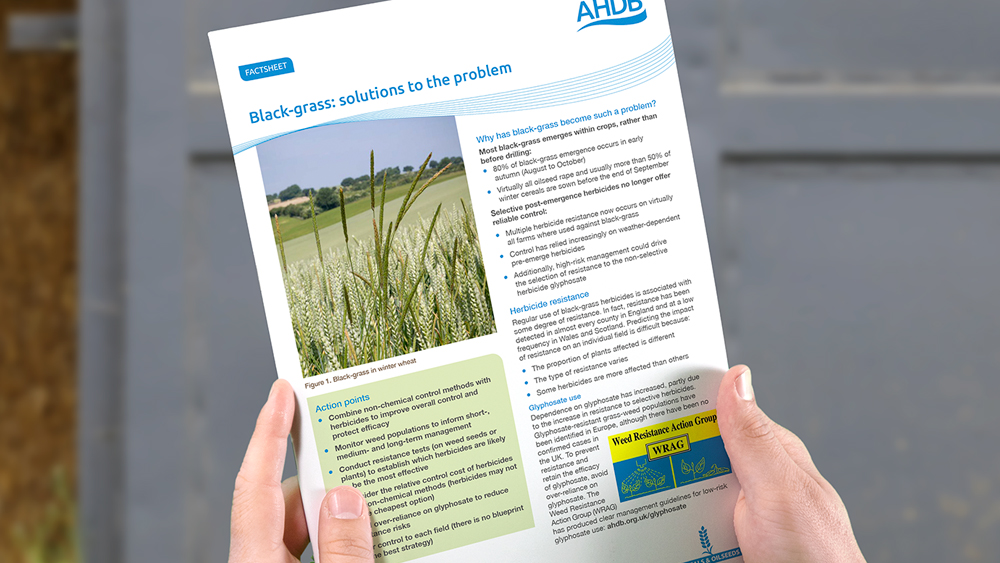- Home
- Knowledge library
- Is black-grass a threat to Scotland?
Is black-grass a threat to Scotland?
Summary
Introdution
Black-grass (Alopecurus myosuroides) is the most prevalent arable weed in England. It causes significant problems to growers, particularly on heavy textured soils in the South and East. Although individual black-grass plants are not highly competitive, seed production is high so populations can increase rapidly unless control is above 95%. Large populations can cause significant yield losses, exceeding 50%.
Several factors have contributed to the rise of black-grass as a major problem in England, including the dominance of autumn cropping, combined with a trend to earlier drilling, which provides ideal conditions for autumn black-grass germination. Simplified rotations of wheat and oilseed rape have also reduced diversity in herbicide programmes. Reduced cultivations, which retain more of the black-grass seed near the surface, has also been a factor. However, resistance to herbicides has been key.
As early as 1982 herbicide resistance was detected in black-grass in England. Since then, resistance to the ALS and ACCase inhibitor groups has spread through most of the arable areas of England. Enhanced metabolism of some other herbicide groups has also reduced their effectiveness, although there are no recorded instances of resistance to the oilseed rape herbicides, carbetamide and propyzamide, nor to glyphosate. Nevertheless, it is now widely accepted that some degree of herbicide resistance occurs on all farms where black-grass active herbicides have been used routinely, even if black-grass was not the target.
Black-grass in Scotland
There are populations of black-grass present naturally in Scotland, although their abundance is low. Warmer winters and more autumn cropping, combined with reduced tillage is likely to encourage these populations to grow and spread. Some may already carry a degree of herbicide resistance if they have been regularly treated with black-grass active herbicides. Laboratory confirmed cases of herbicide resistant black-grass have been found in the Borders though the origin of these populations is uncertain. However, with more than 20,000 farms in England having confirmed black-grass resistance, introduction of resistant black-grass from south of the border is likely to be a more significant threat than development of resistance in native populations.
Although no research has been done, anecdotal evidence suggests a number of routes by which black-grass seed is spread, including on machinery, particularly harvest machinery and bailers, in straw, and as a contaminant in crop seed. As seed, straw and machinery are all imported into Scotland from England all these routes could potentially introduce resistant black-grass onto farms in Scotland. Although black-grass presents a threat to Scotland there are important differences from the farming systems in England which may go some way to mitigating the threat. These include more mixed farms, which can put contaminated fields down to grass, more prevalence of ploughing, which can be an effective control measure when used appropriately and more spring cropping, giving ample opportunity to control the black-grass outside the crop. Nevertheless, experience in England has shown that a small black-grass problem can quickly get outof hand and growers in Scotland need to remain vigilant.
Action points
- Watch out for new or spreading black-grass populations. Remove small populations by hand rouging or spraying off
- Make sure machinery coming onto the farm has been properly cleaned, especially if it has come from England
- Source straw and seed from reputable sources
- If herbicide resistance is suspected, get seed tested so correct management decisions can be made
- Read the full report (at the the bottom of this page) for further information on black-grass in Scotland
Knowledge gaps
Although considerable research has been done on ways to control black-grass, it has been conducted in the South and East of England. Scotland’s cooler, wetter climate may mean that black-grass will behave differently and some of the control options used in England may be less appropriate. In particular, delayed autumn drilling may be more risky in Scotland and may be less effective as seed dormancy may be higher. Additionally, there remain unanswered questions, such as the role of manures in spreading black-grass and how likely it is that black-grass will develop resistance to glyphosate. Ongoing research by AHDB will help fill some of these knowledge gaps and help farmers in Scotland prevent themselves becoming victims of black-grass.
Acknowledgements
The work reported on here was funded from a number of different sources, including UK government through its various agencies, agrochemical companies and other commercial companies, in addition to AHDB. Thanks to all those individuals who contributed to this report by passing on their collective knowledge and experience, including valuable anecdotal information.
Downloads
PR618 Scotland black grass overviewRelated resources


